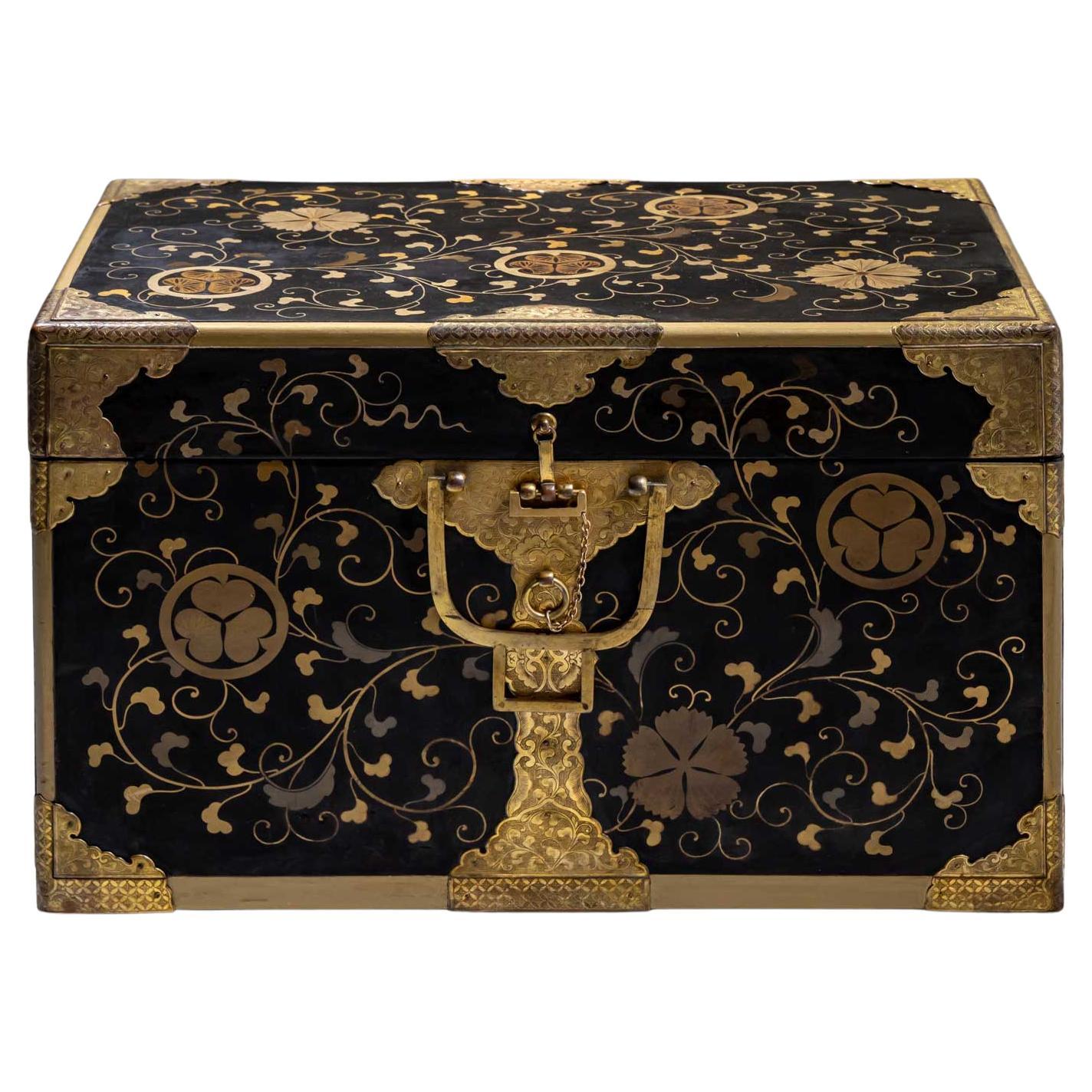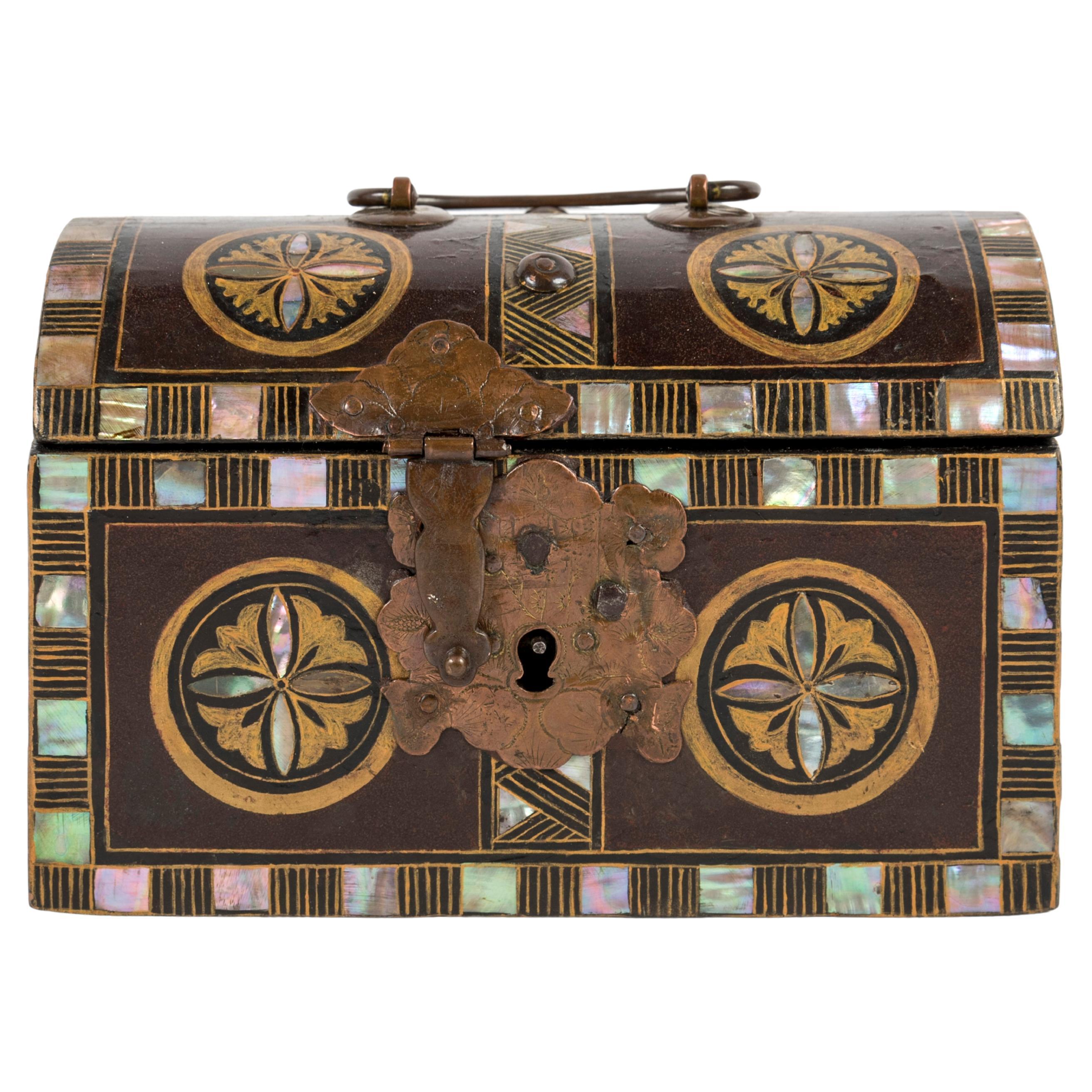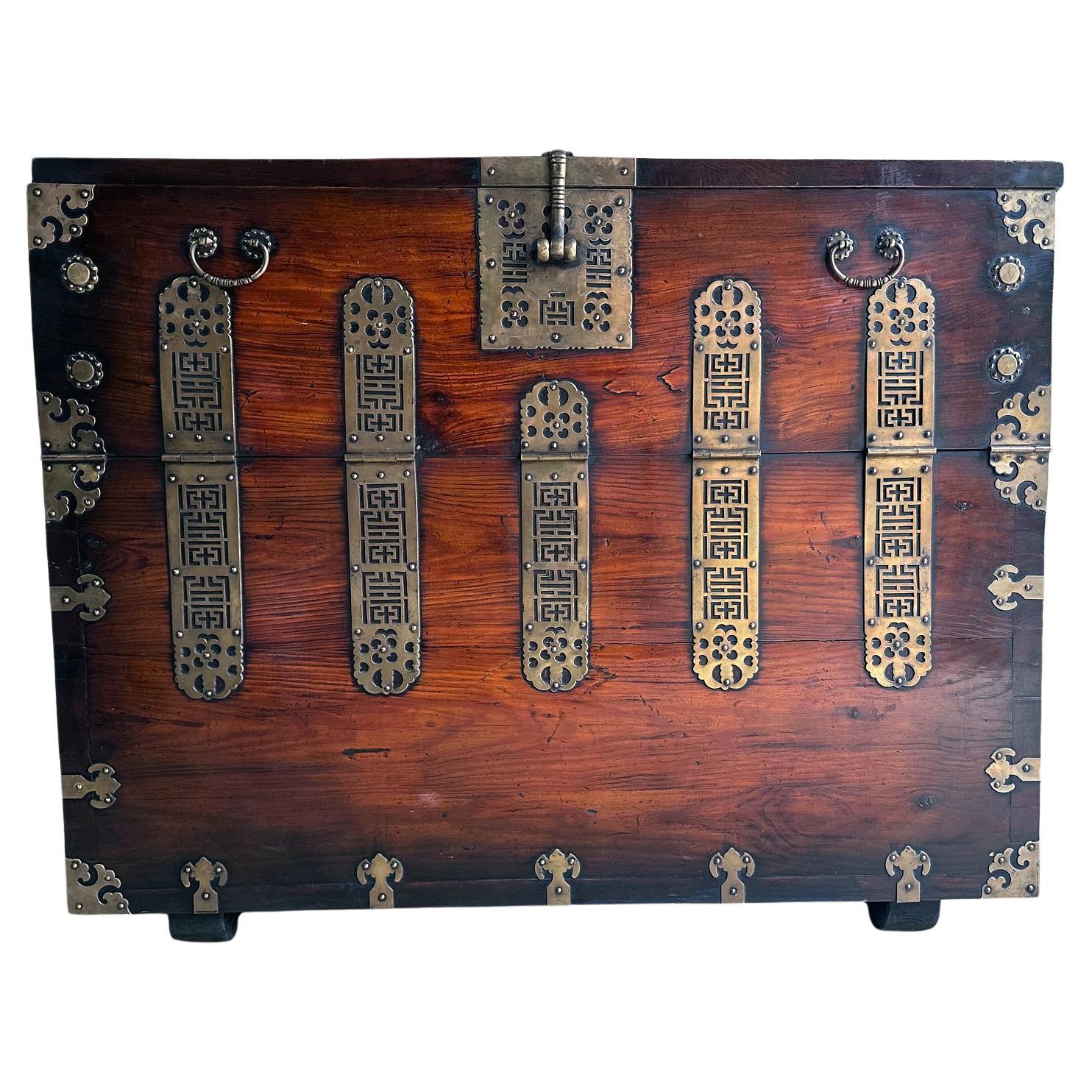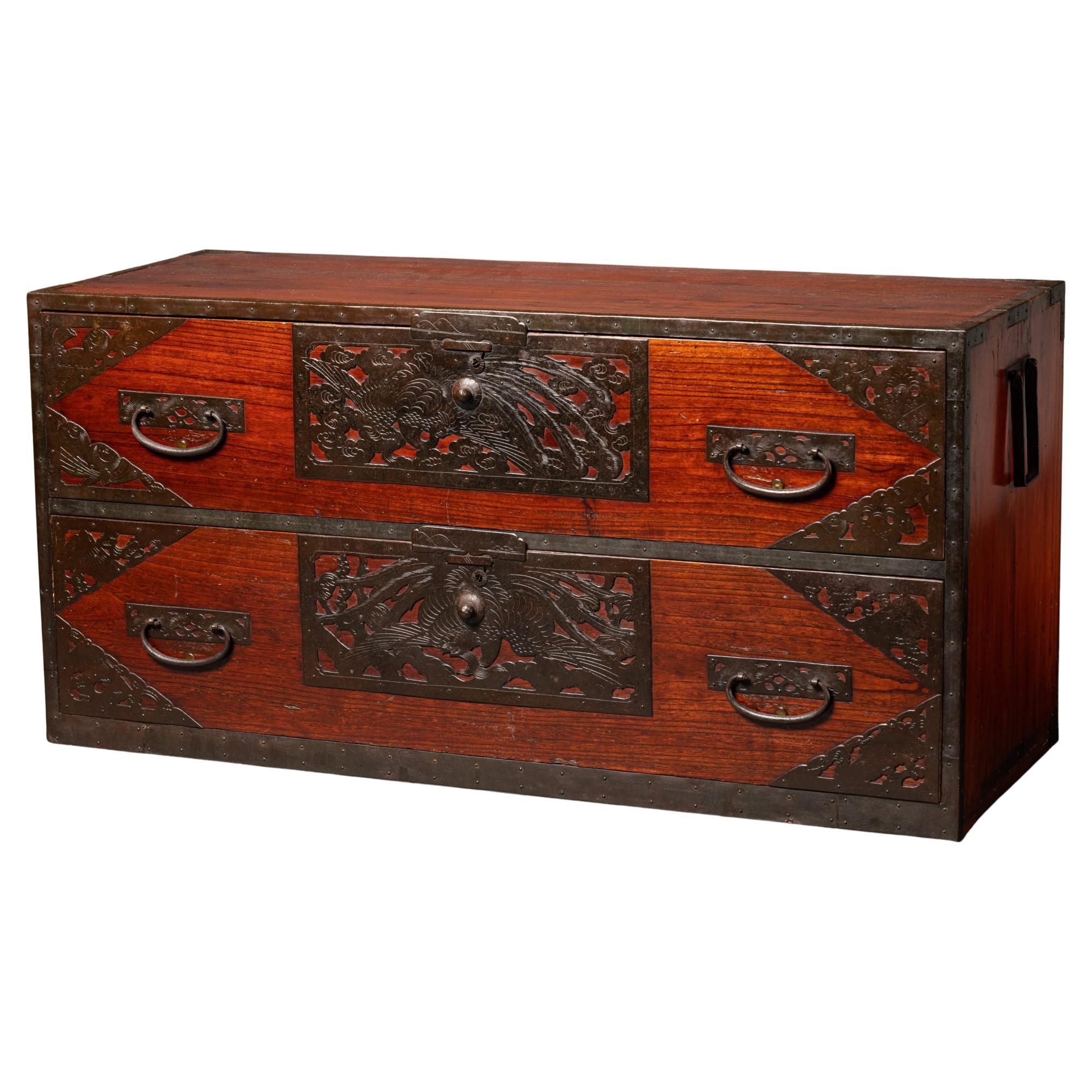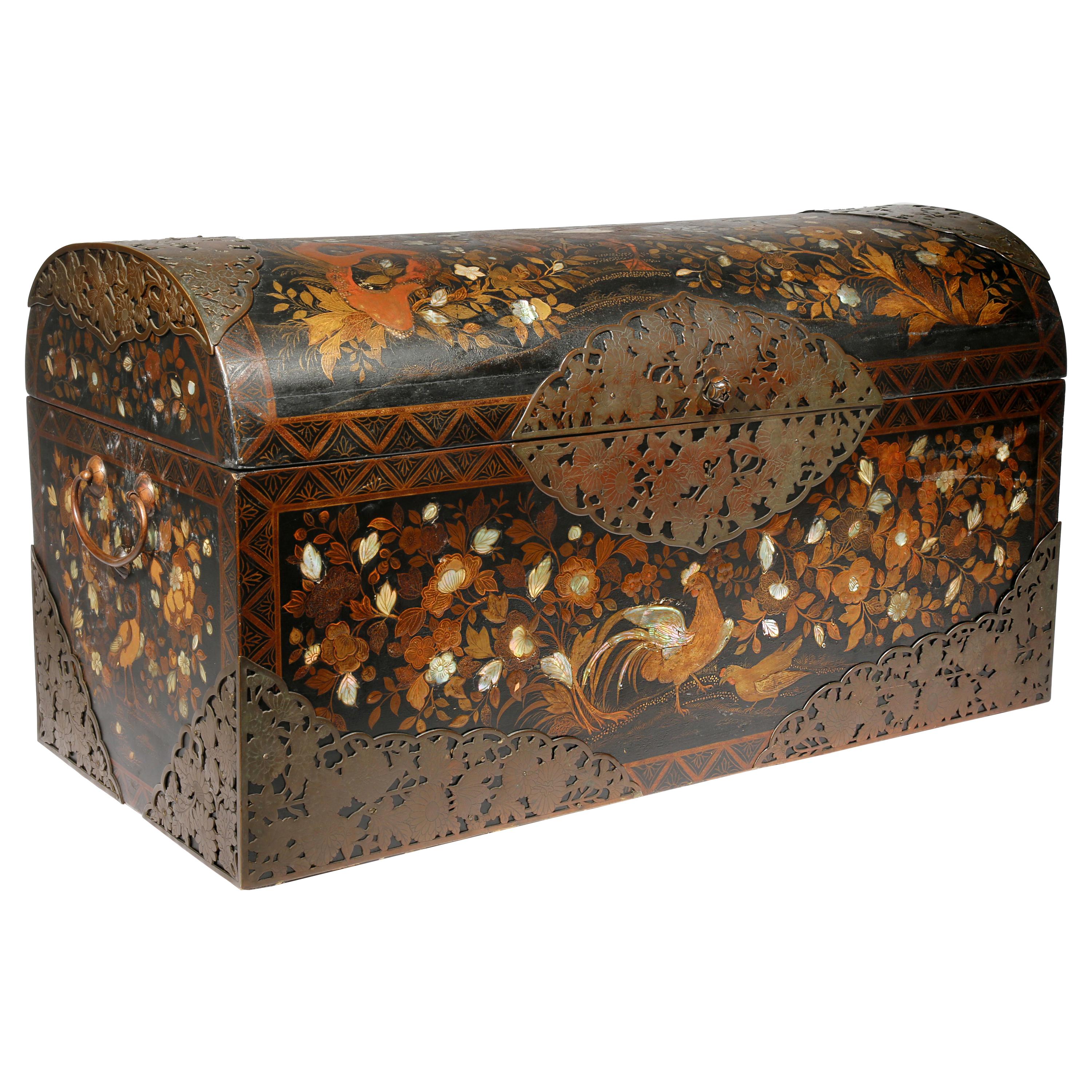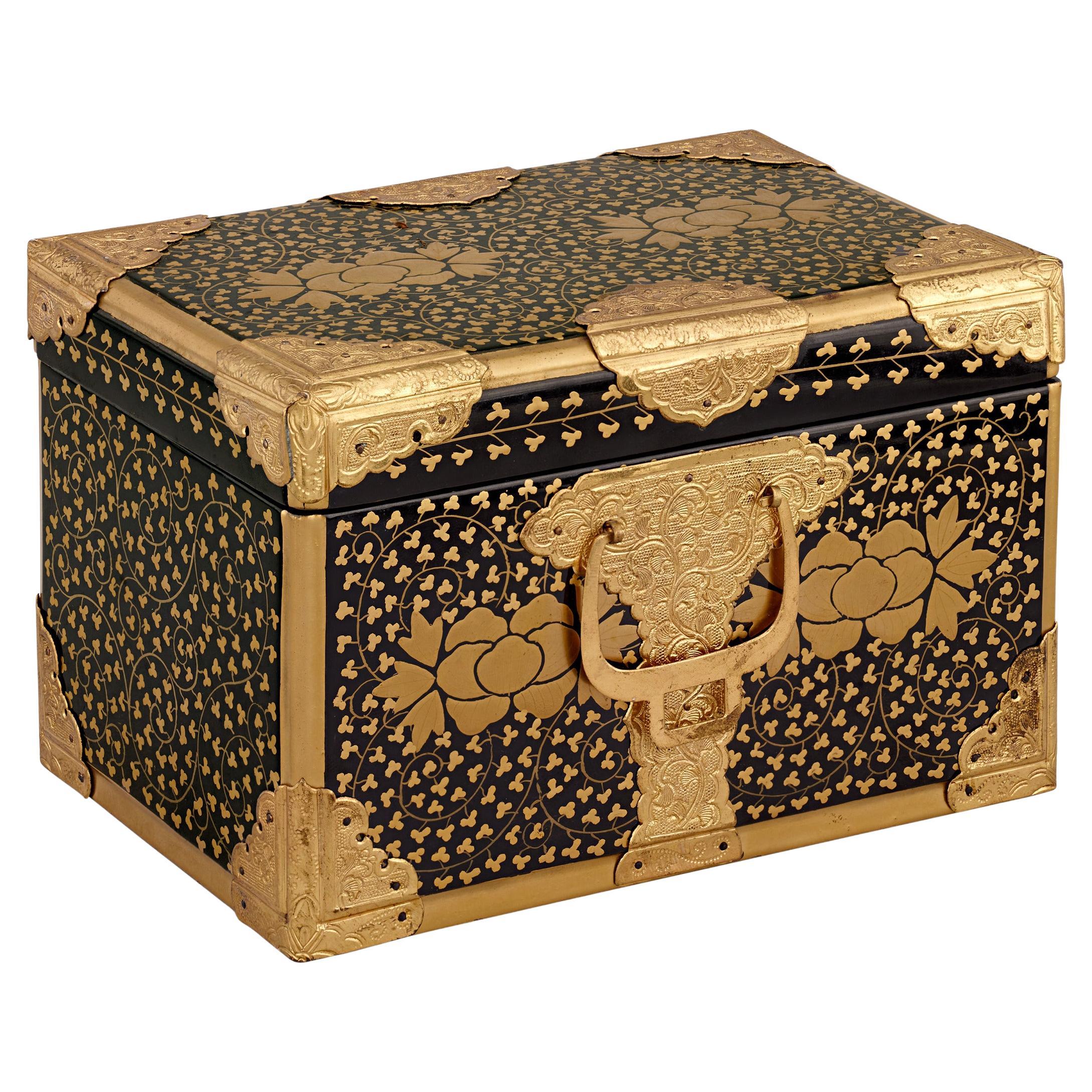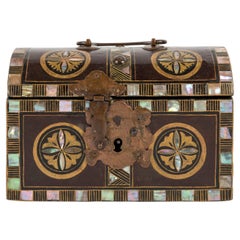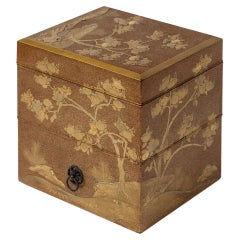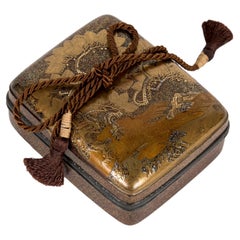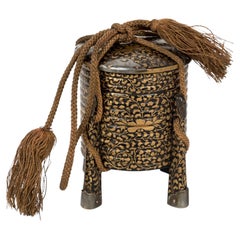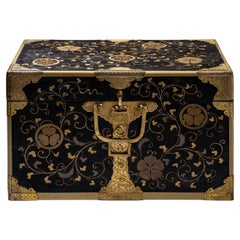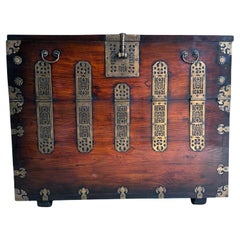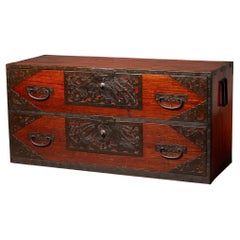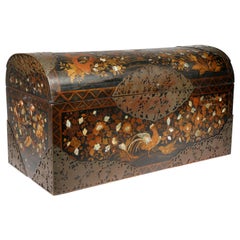Items Similar to Momoyama Namban Chest
Want more images or videos?
Request additional images or videos from the seller
1 of 9
Momoyama Namban Chest
$42,034.52
£30,958.34
€35,000
CA$57,184.68
A$63,544.80
CHF 33,298.15
MX$779,263.68
NOK 424,698.48
SEK 399,540.74
DKK 266,449.62
Shipping
Retrieving quote...The 1stDibs Promise:
Authenticity Guarantee,
Money-Back Guarantee,
24-Hour Cancellation
About the Item
Namban chest with a semi-cylindrical lid made of black lacquered wood (urushi) with gold lacquer (maki-e) and inlaid with mother-of-pearl (raden).
Decorated with three main bands of floral motifs, middle surrounded by vertical bands of mother-of-pearl inlaid lozenges and framed by the hanashippô pattern (overlapping circles forming petals).
On the lied, acer (momiji) and plum tree flowers (ume). On the front side, branches of citrus tree tachibana (Citrus tachibana), vine leaves and peonies (botan). On the right side, bellflowers (kikuyo) and pederas (hagi). Water plantains or Sagittaria (omodaka) on the back side and morning-glories (asagao) on the left side.
Gilded copper fittings chiseled with chrysanthemums, at the bottom what appears to be the head of a dog to either side.
Interior in black lacquer.
Namban art of the 16th and 17th centuries was influenced by contacts and exchanges with the West and in particular the Portuguese who arrived in Japan from the middle of the 16th century. They are called namban-jin, meaning “southern barbarians”. Traders or missionaries went to Japan bringing with them a culture totally different to Japan. Namban lacquerware is characterized by gold maki-e lacquer and inlaid mother-of-pearl (raden) decoration.
Japan – Azuchi Momoyama period (1573-1603)
Height: 6.3 in. (16 cm) – Length: 10.2 in. (23 cm) – Depth: 5.1 in. (13.5 cm).
- Dimensions:Height: 6.3 in (16 cm)Width: 5.32 in (13.5 cm)Depth: 9.06 in (23 cm)
- Materials and Techniques:Lacquer,Lacquered
- Place of Origin:
- Period:
- Date of Manufacture:1573-1603
- Condition:Wear consistent with age and use.
- Seller Location:PARIS, FR
- Reference Number:Seller: 2021-9251stDibs: LU8311234268502
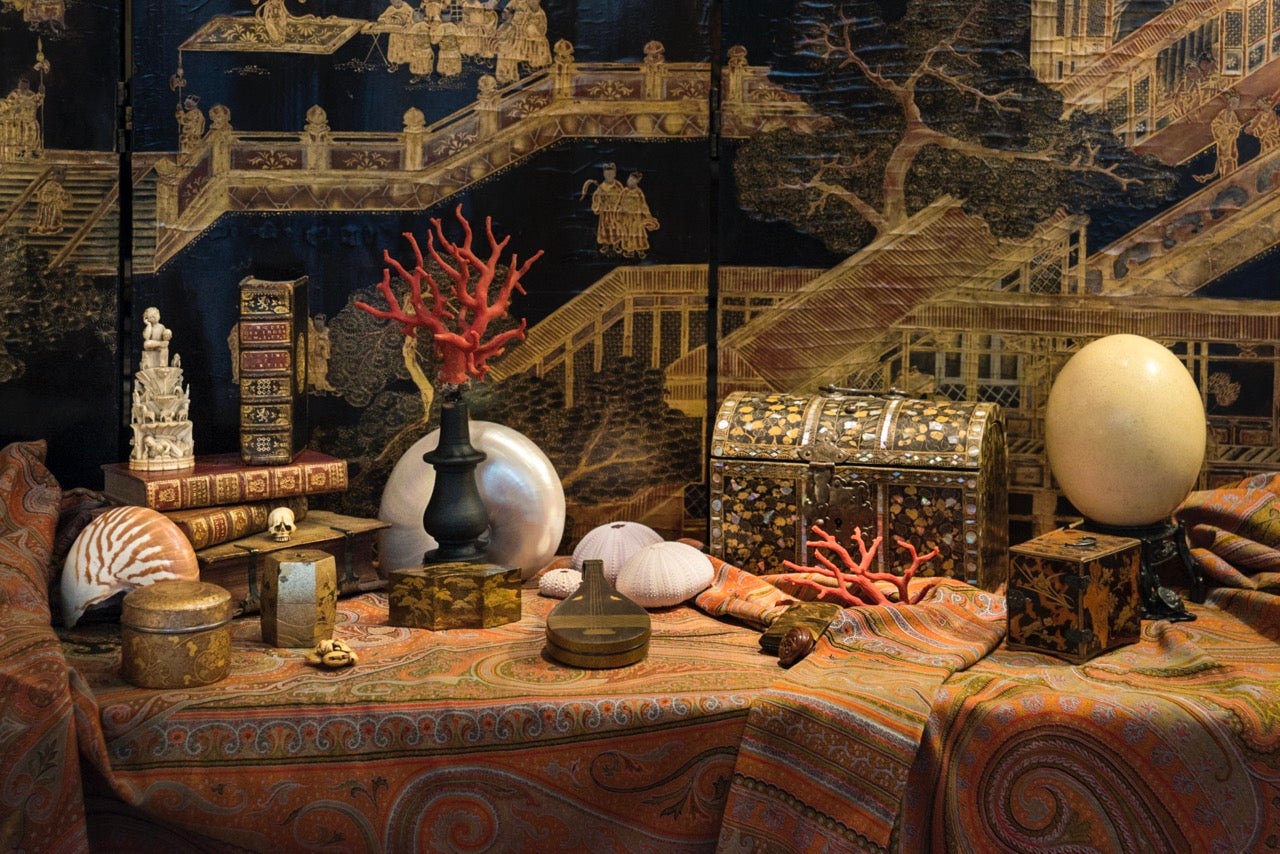
About the Seller
No Reviews Yet
Vetted Professional Seller
Every seller passes strict standards for authenticity and reliability
Established in 2013
1stDibs seller since 2023
Typical response time: Several days
- ShippingRetrieving quote...Shipping from: PARIS, France
- Return Policy
Authenticity Guarantee
In the unlikely event there’s an issue with an item’s authenticity, contact us within 1 year for a full refund. DetailsMoney-Back Guarantee
If your item is not as described, is damaged in transit, or does not arrive, contact us within 7 days for a full refund. Details24-Hour Cancellation
You have a 24-hour grace period in which to reconsider your purchase, with no questions asked.Vetted Professional Sellers
Our world-class sellers must adhere to strict standards for service and quality, maintaining the integrity of our listings.Price-Match Guarantee
If you find that a seller listed the same item for a lower price elsewhere, we’ll match it.Trusted Global Delivery
Our best-in-class carrier network provides specialized shipping options worldwide, including custom delivery.More From This Seller
View AllJapanese Namban Chest adorned with cylindrical motives and mother of pearl inlay
Located in PARIS, FR
Small namban style chest with a semi-cylindrical lid made of black lacquered wood (urushi) with gold lacquer (maki-e) and inlaid with mother-of-pearl (raden).
Mon style decoration (...
Category
Antique Mid-18th Century Japanese Lacquer
Materials
Lacquer, Mother-of-Pearl
Japanese Lacquered Tebako 'Box'
Located in PARIS, FR
Tebako box with three compartments in golden and nashi-ji lacquer, decorated with golden, red, and kirigane lacquer, golden persimmon tree leaves, among rocks. The compartments are of increasing size from the top. The decoration is in continuity.
Persimmon has been cultivated in southern China for more than 2500 years and is believed to have been introduced to Japan in the 8th century. The veneer is a tree with very hard wood, similar to ebony. According to a legend, one specimen survived the atomic bombing of Nagasaki on August 9, 1945, close to the epicenter. It is therefore in Japan a symbol of strength and longevity. It is also the national fruit of the country. It is eaten as a traditional dish during New Year's Day celebrations.
Tebako literally means "portable box...
Category
Antique 1860s Japanese Lacquer
Materials
Lacquer
Japanese landscape pine kobako box Edo period 18th century
Located in PARIS, FR
Rectangular black and gold lacquer kobako box decorated with pine trees in a mountain landscape in takamaki-e, kirigane and hiramaki-e lacquer. Background in nashi-ji lacquer. Surmou...
Category
Antique 18th Century Japanese Lacquer
Materials
Gold
Miniature hokkai bako or kaioke, doll furniture replica of a traditional box
Located in PARIS, FR
Small hokkai bako or kaioke seashells game box, of circular form with its four feet, its bronzes and cordon, decorated with a motive of flowers of gold lacquer on a black lacquer bac...
Category
Antique Late 19th Century Japanese Meiji Lacquer
Materials
Gold, Bronze
Japanese lacquered Cherry Tree Kobako
Located in PARIS, FR
Kobako in nashiji lacquer of square shape with a hira maki-e décor of a blossoming
cherry tree. Both of the four sides are adorned with golden lacquer cherry flowers,
represented i...
Category
Antique 19th Century Japanese Lacquer
Materials
Lacquer
Japanese Tebako in Nashiji lacquer adorned with golden Persimon flowers
Located in PARIS, FR
Tebako box with two compartments in golden and nashi-ji lacquer, decorated with golden, red, and kirigane lacquer, golden persimmon tree leaves, among rocks. The compartments are of ...
Category
Antique Early 19th Century Japanese Meiji Lacquer
Materials
Gold
You May Also Like
Japanese Lacquer Chest, Edo Period
Located in Greding, DE
Small rectangular Japanese chest with gold lacquer decoration in the form of leaf tendrils. The chest is decorated with cut-out and ornamentally engraved fittings on the corners and ...
Category
Antique 18th Century Japanese Edo Decorative Boxes
Materials
Brass
Antique Korean Bandaji Chest Gyeonggi Do Joseon Dynasty
Located in Atlanta, GA
An antique drop front storage chest (known as Bandaji in Korean) circa late 19th century the late Joseon Dynasty. Constructed from thick planks of knotty yellow pine that were hand-h...
Category
Antique Late 19th Century Korean Other Furniture
Materials
Brass
Japanese Chest
Located in Hudson, NY
With two drawers. Top section of a two section chest. Elaborate hardware with cranes and clouds design. Hardware on all corners.
Category
Early 20th Century Japanese Furniture
Materials
Metal
$7,000
Japanese Namban Lacquer and Inlay Coffer Momoyama Period
Located in Atlanta, GA
A rare Japanese Namban Lacquer domed coffer circa 1570-1610s of Azuchi-Momoyama to early Edo period. These types of lacquerware were made for export to ...
Category
Antique 16th Century Japanese Japonisme Lacquer
Materials
Wood, Lacquer
Edo-Period Lacquerware Chest
Located in New Orleans, LA
Edo-Period Lacquerware Chest
19th-century
This exquisite chest, inspired by Hasami-Bako travel trunks, is a striking example of Japanese lacquerware. The hiramaki-e technique—applie...
Category
Antique 19th Century Japanese Edo Decorative Boxes
Materials
Gold
Early 20th Century Japanese Jewelry Box
Located in Dallas, TX
This early 20th century Japanese jewelry box is made of black lacquer and decorated with beautiful floral detailing. This piece sti...
Category
Early 20th Century Japanese Antiquities
More Ways To Browse
Black Japanese Chest
Antique Asian Furniture Chests
Portugal Chest
Lacquer Chest Japan
Asian Black And Gold Decoration
Maki E
Mother Of Pearl Chests
Urushi Lacquer
Used Japanese Chisels
Japanese Lacquer Chest Antique
Morning Glory Antique
Japanese Lacquer Pearl
Japanese Lacquerware
Japanese Lacquer And Mother Of Pearl
16th Century Wood Chest
Japanese Mother Of Pearl Art
Antique Copper Chest
Asian Black Lacquer Pearl Furniture
